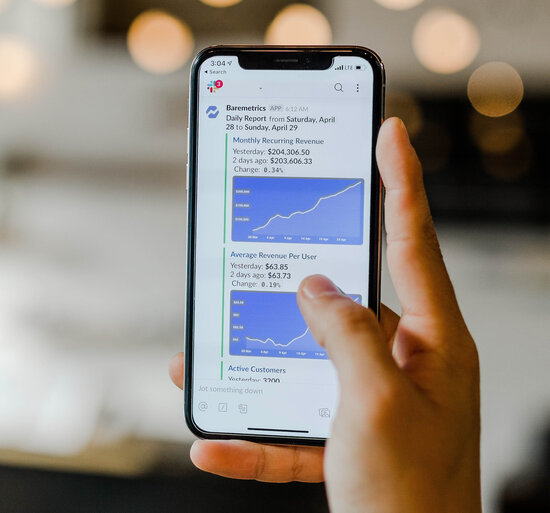Now, with more than half of all internet traffic shopping from mobile devices, it’s very important to make sure your eCommerce website is ready for mobile viewing.
As predicted (based on numerous mobile eCommerce studies and statistics), mobile traffic has surpassed desktop traffic. In 2018, 58% of site visits were from mobile devices.
The data continues to show that for most sites, the majority of their traffic comes from mobile devices.
That’s why we’ve been pointing out the importance of responsive mobile eCommerce website design to our clients for years.
It’s not enough anymore to be “mobile-friendly.” Your eCommerce website should be optimized so that mobile users can complete purchases without having to switch to a desktop or laptop. Because many of them won’t.
Although mobile traffic accounts for more than 50% of all eCommerce traffic, Monetate and others have reported that mobile shoppers’ conversion rates and average order value are a much lower than for desktop users’.
The fact is, it’s now statistically much more likely that eCommerce customers will be interacting with your website from a mobile device (smartphone or tablet) than a desktop. Armed with this knowledge, you have an opportunity to create an eCommerce website that provides a shopping experience that appeals to your customers.
With the highly competitive nature of the eCommerce industry, your customers will not hesitate to buy from your competitors if they run into even the slightest trouble using your mobile eCommerce website.
Statistics show that 40% of users will go to a competitor after a single bad mobile shopping experience and 57% wouldn’t recommend a company with a poorly designed mobile website, yet an alarming 84% of mobile shoppers have experienced difficulty completing a mobile transaction.
84% of mobile shoppers having trouble shopping online is a significantly high number, and it shows just how great the opportunity is for companies to improve eCommerce conversions just by implementing the most desired eCommerce features and following some well known best practices for avoiding shopping cart abandonment.
Mobile shopping cart abandonment rates are as high as 85.6% in some studies. Abandoned eCommerce shoppingg cart rates for desktop and laptop shoppers were 67.9% in 2017 and went up to about 70% for tablet users. That 2.1% difference was small compared to the shopping cart abandonment rates for mobile users.
The lack of conversion for mobile devices is mostly because many retailers aren’t yet providing an optimal mobile checkout experience.
If you plan on running a successful eCommerce website, you should consider the mobile shopping experience and optimizing your eCommerce website for customers using mobile devices.
A mobile optimized website should be a major part of your digital marketing strategy. Not considering those shopping with mobile devices would be to simply ignore the majority of your potential customers.
In short, it’s becoming increasingly crucial to ensure that the shopping and checkout navigation are seamless regardless of the device or screen size being used.
To meet modern customers' expectations, and drive higher checkout conversions, brands must provide experiences that match the mobile users’ contexts, with smaller touch-based screens and in the moment needs.
Mobile device capabilities, limited screen sizes and bandwidth should influence how your mobile eCommerce website is designed.
Weekly testing of a site’s checkout process on all major browsers, operating systems and device combinations are important, because browsers often change their support for particular features.
You should avoid browser-specific details when designing your mobile eCommerce website, and use a responsive design to ensure automatic resizing and reformatting for various screen sizes.
- Redesign your cart to improve mobile checkout
- Use a popup with an inactivity sensor to target abandoning mobile visitors
- Optimize your checkout page for all shoppers, regardless of device
- Overcome common optimization issues to increase conversion rates across all devices
Hopefully, mobile optimization and eCommerce conversion optimization are provided by your mobile eCommerce web development company.
If you’re trying to make mobile website improvements on your own, here are some tips to make your eCommerce website more mobile friendly:
A few tips for delivering mobile optimized contextual checkout experiences:
-
Auto-detect as much information as possible. Save mobile users time and taps by auto-detecting city and state based on zip code and auto-detecting card type based on their card number.
-
Provide input optimizations for keyboards like disabled auto-correct for name fields and numeric keyboards for phone and credit card information.
70% of top mobile optimized eCommerce sites fall short in terms of these optimizations.
-
Auto-complete as often as possible. 62% of eCommerce sites use standard text auto-completion. On mobile, where every tap you save a customer provides a better experience, it’s even more crucial.
-
Provide a click-to-call feature or live chat for mobile users to quickly resolve any ordering, billing or shipping issues.
-
Call link phone numbers: Make sure all phone numbers are linked with call links,(e.g. 888-211-7806) so shoppers can tap-to-call.
-
Tap-Friendly: make sure all buttons, links and calls to action have the appropriate size and space to enable clicks and prevent errors.
-
Contact Forms: Increase form input field sizes, so it’s easy for customers to fill out forms.
Conclusion
Your mobile eCommerce website’s conversion rate can be greatly improved by considering the mobile shopping experience and optimizing your eCommerce website for customers using mobile devices.
Contact us for a free evaluation of your mobile eCommerce website.



